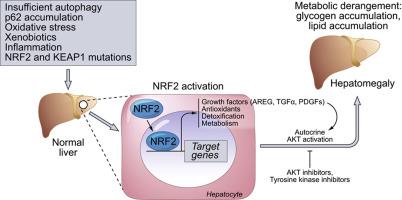当前位置:
X-MOL 学术
›
J. Hepatol.
›
论文详情
Our official English website, www.x-mol.net, welcomes your
feedback! (Note: you will need to create a separate account there.)
NRF2 Activates Growth Factor Genes and Downstream AKT Signaling to Induce Mouse and Human Hepatomegaly
Journal of Hepatology ( IF 26.8 ) Pub Date : 2020-06-01 , DOI: 10.1016/j.jhep.2020.01.023 Feng He 1 , Laura Antonucci 1 , Shinichiro Yamachika 1 , Zechuan Zhang 2 , Koji Taniguchi 1 , Atsushi Umemura 1 , Georgia Hatzivassiliou 3 , Merone Roose-Girma 3 , Miguel Reina-Campos 4 , Angeles Duran 4 , Maria T Diaz-Meco 4 , Jorge Moscat 4 , Beicheng Sun 2 , Michael Karin 5
Journal of Hepatology ( IF 26.8 ) Pub Date : 2020-06-01 , DOI: 10.1016/j.jhep.2020.01.023 Feng He 1 , Laura Antonucci 1 , Shinichiro Yamachika 1 , Zechuan Zhang 2 , Koji Taniguchi 1 , Atsushi Umemura 1 , Georgia Hatzivassiliou 3 , Merone Roose-Girma 3 , Miguel Reina-Campos 4 , Angeles Duran 4 , Maria T Diaz-Meco 4 , Jorge Moscat 4 , Beicheng Sun 2 , Michael Karin 5
Affiliation

|
BACKGROUND & AIMS
Hepatomegaly can be triggered by insulin and insulin-unrelated etiologies. Insulin acts via AKT, but how other challenges cause hepatomegaly is unknown. METHODS
Since many hepatomegaly-inducing toxicants and stressors activate NRF2, we examined the effect of NRF2 activation on liver size and metabolism using a conditional allele encoding a constitutively active NRF2 variant to generate Nrf2Act-hep mice in which NRF2 is selectively activated in hepatocytes. We also used adenoviruses encoding variants of the autophagy adaptor p62/SQSTM1, which activates liver NRF2, as well as liver-specific ATG7-deficient mice (Atg7Δhep) and liver specimens from patients with hepatic sinusoidal obstruction syndrome (HSOS) and autoimmune hepatitis (AIH). RNA sequencing and cell signaling analyses were used to determine cellular consequences of NRF2 activation and diverse histological analyses were used to study effects of the different manipulations on liver and systemic pathophysiology. RESULTS
Hepatocyte-specific NRF2 activation, due to p62 accumulation or inhibition of KEAP1 binding, led to hepatomegaly associated with enhanced glycogenosis, steatosis and G2/M cell cycle arrest, fostering hyperplasia without cell division. Surprisingly, all manipulations that led to NRF2 activation also activated AKT, whose inhibition blocked NRF2-induced hepatomegaly and glycogenosis, but not NRF2-dependent anti-oxidant gene induction. AKT activation was linked to NRF2-mediated transcriptional induction of PDGF and EGF receptor ligands that signaled through their cognate receptors in an autocrine manner. Insulin and insulin-like growth factors were not involved. The NRF2-AKT signaling axis was also activated in human HSOS- and AIH-related hepatomegaly. CONCLUSIONS
NRF2, a transcription factor readily activated by xenobiotics, oxidative stress and autophagy disruptors, may be a common mediator of hepatomegaly; its effects on hepatic metabolism can be reversed by AKT and tyrosine kinase inhibitors.
中文翻译:

NRF2 激活生长因子基因和下游 AKT 信号传导诱导小鼠和人类肝肿大
背景与目的 胰岛素和与胰岛素无关的病因可引发肝肿大。胰岛素通过 AKT 发挥作用,但其他挑战如何导致肝肿大尚不清楚。方法 由于许多引起肝肿大的毒物和应激源都会激活 NRF2,因此我们使用编码组成型活性 NRF2 变体的条件等位基因来检测 NRF2 激活对肝脏大小和代谢的影响,以产生 Nrf2Act-hep 小鼠,其中 NRF2 在肝细胞中被选择性激活。我们还使用了编码自噬接头 p62/SQSTM1 变体的腺病毒,该接头可激活肝脏 NRF2,以及肝脏特异性 ATG7 缺陷小鼠 (Atg7Δhep) 以及来自肝窦阻塞综合征 (HSOS) 和自身免疫性肝炎 (AIH) 患者的肝脏标本)。 RNA测序和细胞信号分析被用来确定NRF2激活的细胞后果,并且多种组织学分析被用来研究不同操作对肝脏和全身病理生理学的影响。结果 由于 p62 积累或 KEAP1 结合抑制,肝细胞特异性 NRF2 激活导致肝肿大,并伴有糖原生成增强、脂肪变性和 G2/M 细胞周期停滞,促进增生而不发生细胞分裂。令人惊讶的是,所有导致 NRF2 激活的操作也会激活 AKT,AKT 的抑制作用会阻止 NRF2 诱导的肝肿大和糖原生成,但不会阻止 NRF2 依赖性抗氧化基因的诱导。 AKT 激活与 NRF2 介导的 PDGF 和 EGF 受体配体转录诱导有关,PDGF 和 EGF 受体配体通过其同源受体以自分泌方式发出信号。胰岛素和胰岛素样生长因子不参与其中。 NRF2-AKT 信号轴在人类 HSOS 和 AIH 相关肝肿大中也被激活。 结论 NRF2 是一种容易被异生素、氧化应激和自噬干扰物激活的转录因子,可能是肝肿大的常见介质。 AKT 和酪氨酸激酶抑制剂可逆转其对肝脏代谢的影响。
更新日期:2020-06-01
中文翻译:

NRF2 激活生长因子基因和下游 AKT 信号传导诱导小鼠和人类肝肿大
背景与目的 胰岛素和与胰岛素无关的病因可引发肝肿大。胰岛素通过 AKT 发挥作用,但其他挑战如何导致肝肿大尚不清楚。方法 由于许多引起肝肿大的毒物和应激源都会激活 NRF2,因此我们使用编码组成型活性 NRF2 变体的条件等位基因来检测 NRF2 激活对肝脏大小和代谢的影响,以产生 Nrf2Act-hep 小鼠,其中 NRF2 在肝细胞中被选择性激活。我们还使用了编码自噬接头 p62/SQSTM1 变体的腺病毒,该接头可激活肝脏 NRF2,以及肝脏特异性 ATG7 缺陷小鼠 (Atg7Δhep) 以及来自肝窦阻塞综合征 (HSOS) 和自身免疫性肝炎 (AIH) 患者的肝脏标本)。 RNA测序和细胞信号分析被用来确定NRF2激活的细胞后果,并且多种组织学分析被用来研究不同操作对肝脏和全身病理生理学的影响。结果 由于 p62 积累或 KEAP1 结合抑制,肝细胞特异性 NRF2 激活导致肝肿大,并伴有糖原生成增强、脂肪变性和 G2/M 细胞周期停滞,促进增生而不发生细胞分裂。令人惊讶的是,所有导致 NRF2 激活的操作也会激活 AKT,AKT 的抑制作用会阻止 NRF2 诱导的肝肿大和糖原生成,但不会阻止 NRF2 依赖性抗氧化基因的诱导。 AKT 激活与 NRF2 介导的 PDGF 和 EGF 受体配体转录诱导有关,PDGF 和 EGF 受体配体通过其同源受体以自分泌方式发出信号。胰岛素和胰岛素样生长因子不参与其中。 NRF2-AKT 信号轴在人类 HSOS 和 AIH 相关肝肿大中也被激活。 结论 NRF2 是一种容易被异生素、氧化应激和自噬干扰物激活的转录因子,可能是肝肿大的常见介质。 AKT 和酪氨酸激酶抑制剂可逆转其对肝脏代谢的影响。









































 京公网安备 11010802027423号
京公网安备 11010802027423号